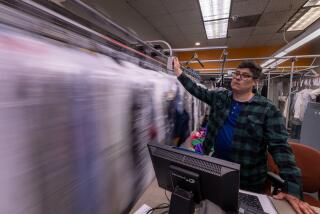‘Out!’ Boyle Heights activists say white art elites are ruining the neighborhood...but it’s complicated

- Share via
A century ago, if you’d uttered the word “artist,” chances are it would have been accompanied by the modifier “starving.”
Consider the tubercular waifs of Puccini’s “La Bohème” burning manuscripts to stay warm in their Paris garrets. Or New York’s Abstract Expressionists drinking nickel coffee at Depression-era cafeterias.
Today, artists are more liable to be described as the “gentrifying foot soldiers of capitalism,” harbingers of highfalutin coffee and six-figure loft living.
That is certainly the case in Boyle Heights, where a number of art spaces have materialized in the industrial zone just west of the 101 Freeway over the last three years, raising alarms among longtime residents about gentrification.
Last month, protesters led a march in the neighborhood, putting up mock eviction notices. One of their targets: the 4,500-square-foot gallery on South Anderson Street recently launched by United Talent Agency, the Hollywood powerhouse that represents fine artists such as Ai Weiwei and Judy Chicago in the world of entertainment. (The space is currently displaying work by filmmaker and photographer Larry Clark.)
“You are hereby notified by the people of Boyle Heights, who have fought for decades to preserve affordable housing for low-income families,” read the notice, “that you must remove your business from the neighborhood immediately.”
The crowd then headed across the street to MaRS (short for Museum as Retail Space), where they chanted, “Fuera! Fuera! Fuera!” (Out! Out! Out!) at gallery-goers in the midst of an opening.
“The idea of ‘get out’ is unrealistic,” says gallerist Eva Chimento, who runs Chimento Contemporary out of a 1,600-square-foot space on South Anderson Street. “And the problem I’m having with the ‘get out’ is the threats that come with it. The activist groups are great, but now you have these kids behind them who are taking it to extremes.”
PSSST, a nonprofit arts space that opened on East 3rd Street in the spring, has had feces flung at the building. This week, various galleries on South Anderson Street got tagged, one with obscene graffiti against “white art.”
The only way we are heard is when you say no. And that’s terrifying because you’re a jerk who says no.
— Leonardo Vilchis, activist
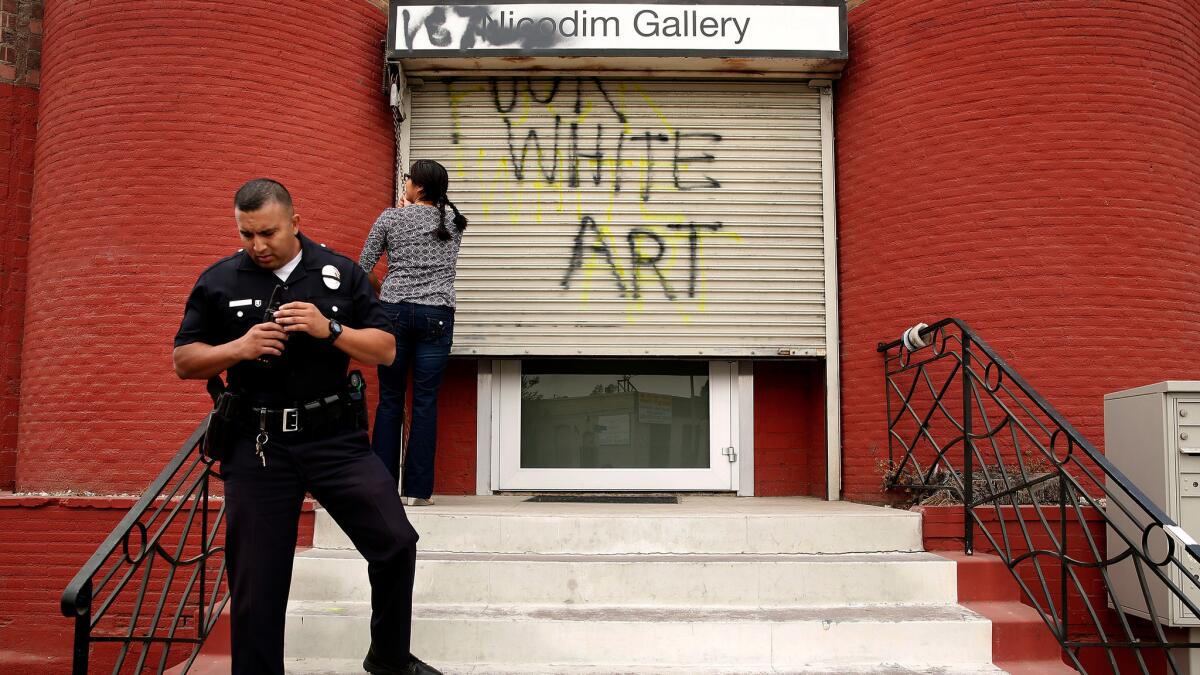
Boyle Heights isn’t the only place where the arrival of artists has sparked wariness. In New York’s Chinatown, longtime residents have been meeting to discuss the neighborhood’s influx of galleries. In London, there has been concern about the role of art in gentrifying multicultural districts such as Peckham.
“It used to be that art was regarded as something homegrown,” says urban planner and East L.A. native John Arroyo, who studies Latino growth at the Massachusetts Institute of Technology. “Now, it’s super-commodified.”
Josefina López, a playwright and screenwriter (best known for “Real Women Have Curves”) who founded Casa 0101 Theater in Boyle Heights, wrote and staged a short play earlier this year titled “Hipsteria,” about a Boyle Heights of the future in which an activist mom is evicted from her apartment so that it can be transformed into a dog hotel. Her concern about the galleries is that they could supplant the identity of the Mexican American heart of Los Angeles.
“Artists who didn’t grow up in Boyle Heights, they look at Boyle Heights as a blank canvas,” she says. “They don’t realize they are painting over another work of art.”
Our intent is not to turn this into an arts district where artists can’t afford to live anymore.
— Geoff Anenberg, developer
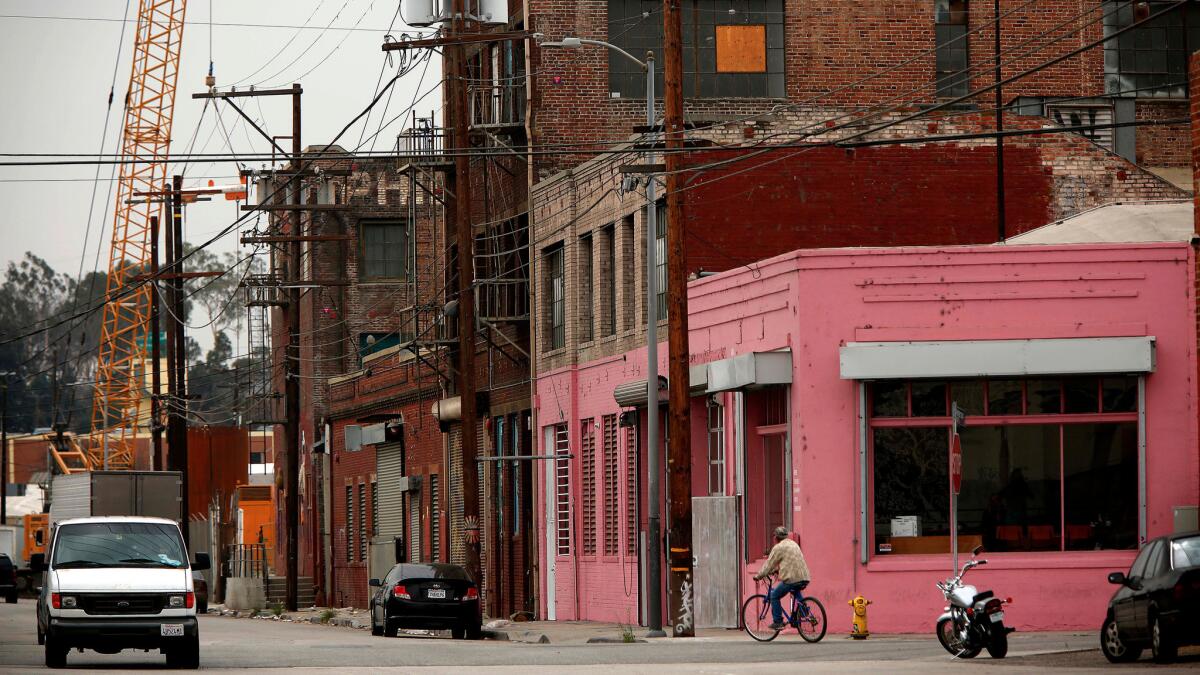
As with all things gentrification — a catch-all that has come to signify everything from small-scale urban improvements to the wholesale transformation of neighborhoods — the reasons art has become vilified are complex and even a little bit surprising.
The data, for one, don’t always support the idea that fine art is a gentrifying agent.
A 2012 report published by the National Endowment for the Arts and the Brookings Institution analyzed whether the opening of a new gallery had any effect on development trends in New York neighborhoods and found that the difference was minimal. Galleries weren’t causing development as much as mirroring it.
In addition, a 2014 study published by the Journal of the American Planning Assn. shows that fine arts are more connected to neighborhood revitalization (improvements without signs of displacement) than to gentrification. They define gentrification as a phenomenon that consists of “upscaling” (partly, a decline in residents in public assistance) and “build-out” (a rising proportion of new homeowners with higher levels of income — a.k.a. condo dwellers).
The study notes that commercial arts — the music, film and design industries — have a more significant connection to gentrification. (Which means Warner Music setting up its headquarters across the river in the Arts District could affect Boyle Heights more than art galleries.)
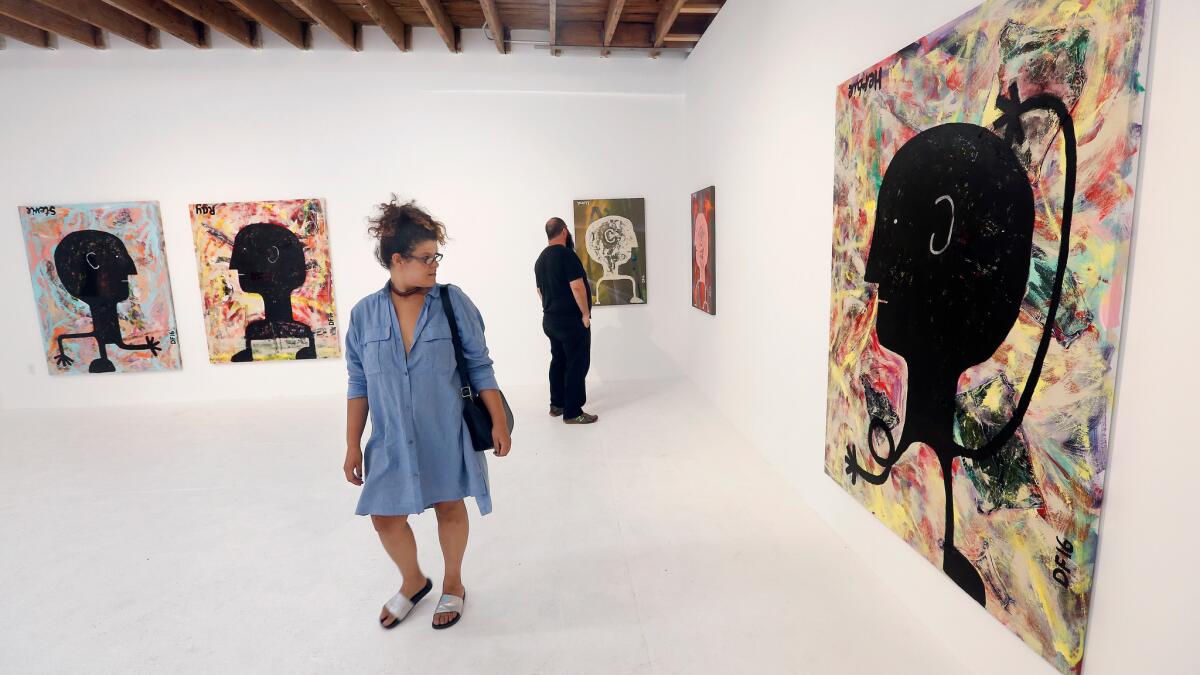
But just because the data don’t show a direct link between art and gentrification doesn’t mean that urban planners haven’t gotten wise to the cachet that artists bring to a neighborhood.
“There are many anecdotes of developers watching where artists go and using that to track what neighborhoods they can wring money out of,” says Brooklyn-based artist Jennifer Dalton, who recently helped lead a month-long art project titled “Month2Month,” which touched on issues of art, housing and inequity. “And when there is displacement, that’s when problems arise.”
While fine art may not cause gentrification, the arts in general, according to a Journal of the American Planning Assn. study, have come to play “a more direct role” as instruments of urban planning and policy.
Some of this, states the report, dates back to the success of the Guggenheim Museum Bilbao, which rocketed the Spanish city from sleepy port to international design destination.
Also key: The 2002 publication of economist Richard Florida’s book “Rise of the Creative Class” — which posited that the new American economy would be driven by knowledge workers (programmers, designers, etc.). “As many case studies show,” state the report’s authors, “city officials [inspired by the book] have invested in smaller-scale, arts-themed areas as amenities to attract skilled labor and engender neighborhood redevelopment.”
Some communities don’t have a background of resistance. But Boyle Heights does.
— Harry Gamboa, artist
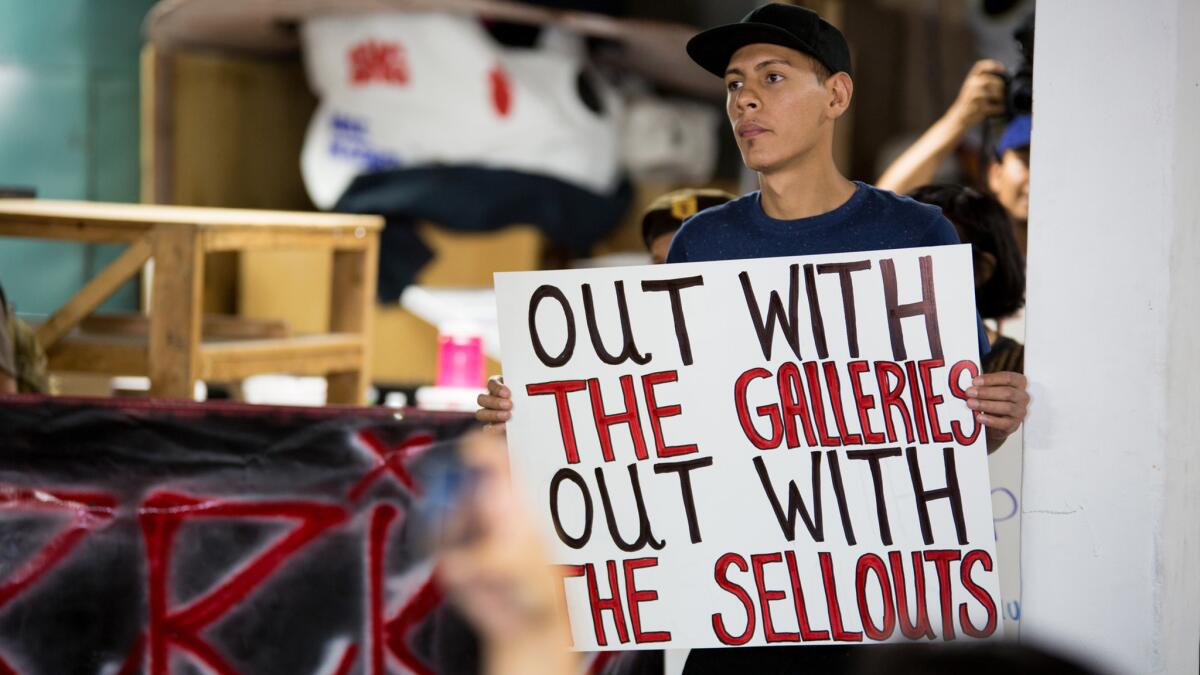
It is the connection between art and real estate that activists in Boyle Heights have their eye on. In the past three years, beginning with the 2013 launch of 356 Mission, more than a dozen galleries have appeared in Boyle Heights — including Maccarone and Venus Over Los Angeles, which are outposts of prominent New York galleries, as well as more modest local spaces such as Chimento Contemporary and MaRS.
A good number of arts-related properties (including studios and galleries) are owned by Vera R. Campbell, who runs a local clothing manufacturer, and have been managed by Creative Space, a downtown real estate company.
Campbell declined to be interviewed for this story, but Geoff Anenberg, a partner at Creative Space, says the aim wasn’t to jack up property values so that they could plunk down condos.
“Our intent is not to turn this into an arts district where artists can’t afford to live anymore,” he explains. “These artists have long-term leases at fixed rates. You don’t do that when you’re just trying to attract people and then turn it and burn it.”
His interest, he says, is seeing some of L.A.’s older industrial architecture preserved. (Some of the warehouses date to the 1930s.) “My intent is simple,” he says. “These buildings are beautiful, so let’s do this in a way that has minimal intervention; let’s keep it low impact.”
But he says he realizes how his idea of low impact doesn’t read that way in Boyle Heights: “What I do shines a light, and that light has a wake and that wake is spilling into the neighborhood.”
And that light has generated unprecedented opposition.

“Some communities don’t have a background of resistance,” says artist Harry Gamboa Jr., who grew up in the neighborhood and was one of the founding members of the collective Asco. “But Boyle Heights does. And it has an intellectual base that goes back to the Chicano Movement, back to the era of the Pachucos.”
Part of that stems from the urban raw deals Boyle Heights has gotten over the last half century: The 135 acres of freeway that run indiscriminately through the neighborhood. The contamination unleashed by the Exide plant in nearby Vernon. And the plan, put forth two years ago by the Metropolitan Transit Authority, that would have brought 120,000 square feet of retail and office space around Mariachi Plaza — without any input from local residents. (The project was scrapped.)
Now activists from a loose coalition called the Boyle Heights Alliance Against Artwashing and Displacement are demanding that the galleries leave.
“The only way you can start this conversation is by saying no,” says Leonardo Vilchis, who has been a resident of Boyle Heights since 1986 and helped establish Union de Vecinos, a nonprofit activist group that works on housing and other community development issues. “The only way we are heard is when you say no. And that’s terrifying because you’re a jerk who says no. But we have had more negotiations now since we’ve said no than if we had said yes.”
There are more pressing needs in Boyle Heights than galleries, he says. “People would like to have an education center, another supermarket, housing to live in — the bad news is, they don’t have big investors backing them to make this happen.”
Nobody is watching this. Communities become beholden to these benevolent developers who will make concessions for housing and parks and services.
— John Arroyo, urban planner
Arroyo says that part of the conflict stems from lack of city involvement. (José Huizar, the councilman who represents the district, did not respond to requests for comment.)
“Nobody is watching this,” says Arroyo. “So communities become beholden to these benevolent developers who will make concessions for housing and parks and services. And then when it doesn’t happen, nobody holds them to it.”
The scarcity of housing — especially of the affordable and low-income variety — is a large part of the problem. According to the L.A. Department of City Planning’s 2014 Growth & Infrastructure Report, Boyle Heights had just a 1.4% increase in units from 2010 to 2014. The average for the rest of the city was 5.7%.
“There is this idea that art can be this panacea,” says Arroyo. “So many people I know working in the field say it’s a wonderful thing. But it won’t get much done on its own to shift all of the other agents of change.”
Even neighborhood arts organizations have gotten caught up in the rhetorical crossfire.
This summer, Self Help Graphics & Art, a community visual arts center that has been an Eastside fixture since 1973, held a meeting about gentrification that was crashed by activists who accused it of being part of the problem. (Something that generated outrage among older Chicano artists for whom Self Help has been an important outpost of artistic and community identity.)
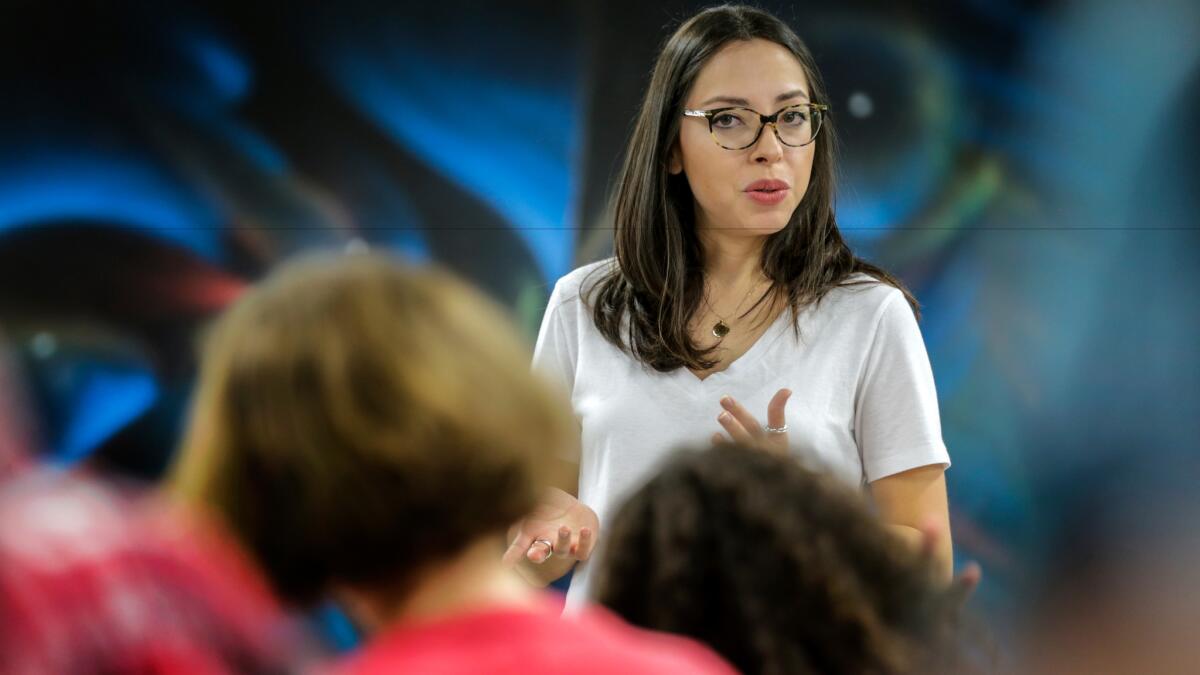
“We are not a commercial gallery,” says Betty Avila, who helps oversee the nonprofit, which provides youth programs, operates a print atelier and organizes Day of the Dead festivities.
“When Sister Karen [Boccalero, the nun who helped found Self Help] and the artists got together to create this space in the early ‘70s, it was so art could be created on the community’s terms and not dictated in any way by what she called ‘institutions,’” she explains. “That intention continues to be the fuel for why Self Help exists.”
Plus, Self Help isn’t immune from gentrification’s effects.
It occupies a former fish-packing plant on East 1st street. The lease expires in four years.
Sign up for our weekly Essential Arts & Culture newsletter »
Find me on Twitter @cmonstah.
ALSO
Boyle Heights activists blame the art galleries for gentrification
‘All Power to the People’ explores the often misunderstood history of the Black Panther movement
What a Holocaust survivor has to say to South L.A. school kids — and how she uses art to connect
Gentrification pushes up against Boyle Heights — and vice versa
More to Read
The biggest entertainment stories
Get our big stories about Hollywood, film, television, music, arts, culture and more right in your inbox as soon as they publish.
You may occasionally receive promotional content from the Los Angeles Times.


